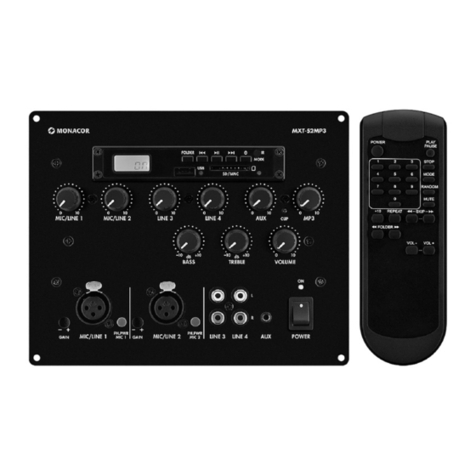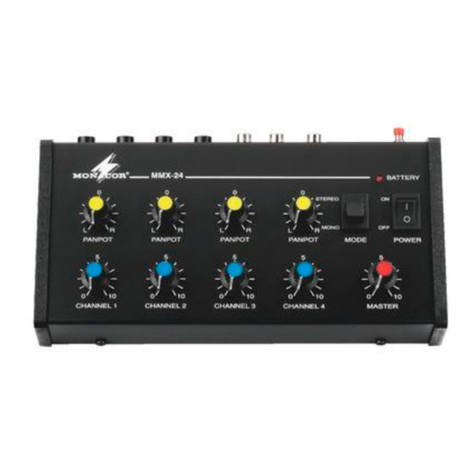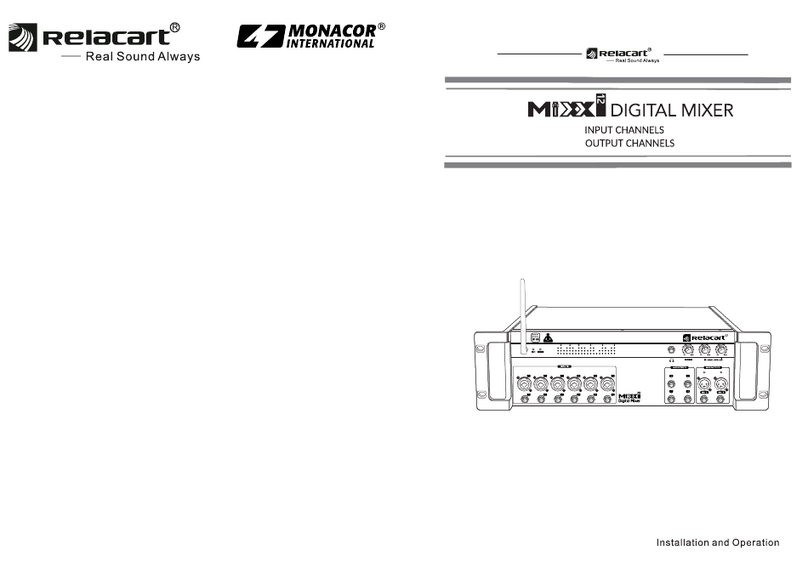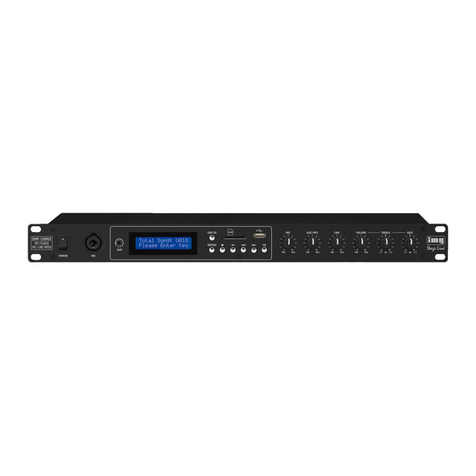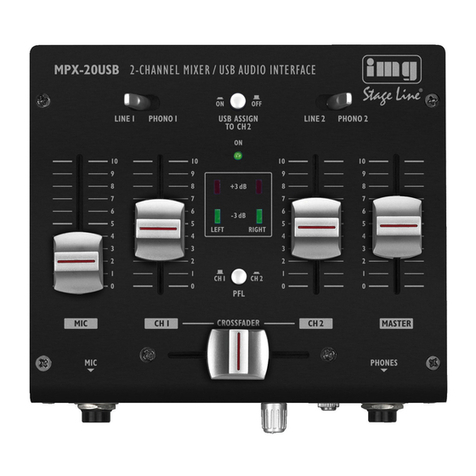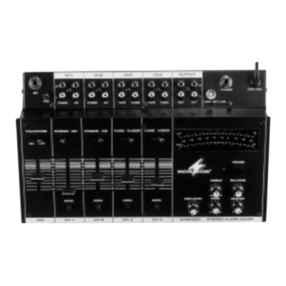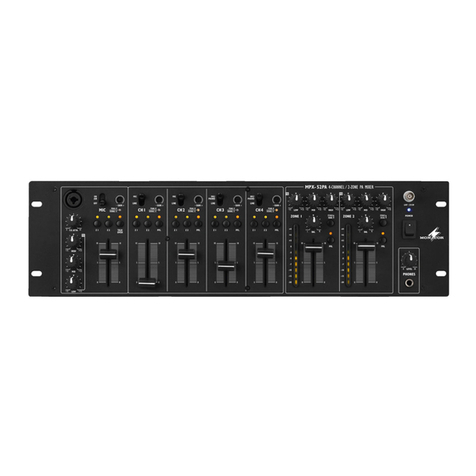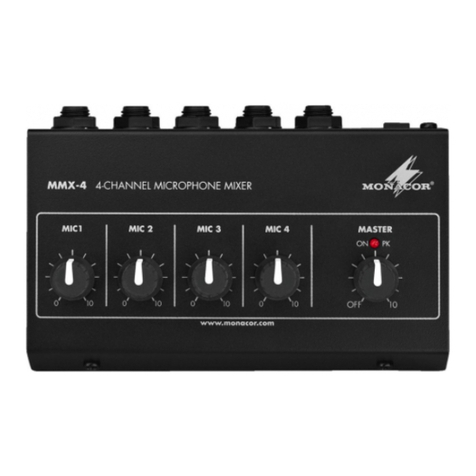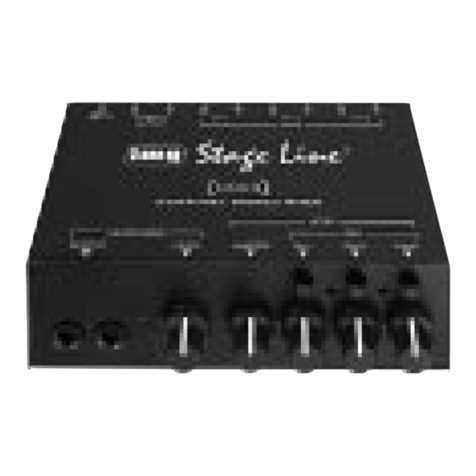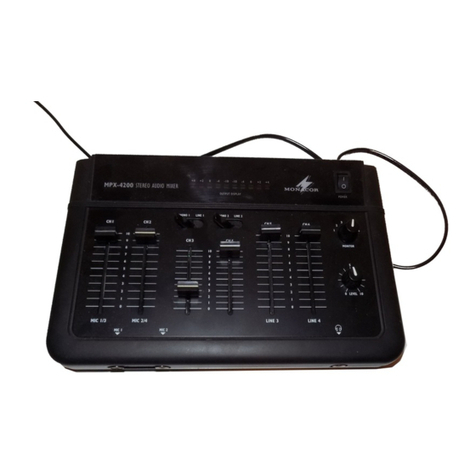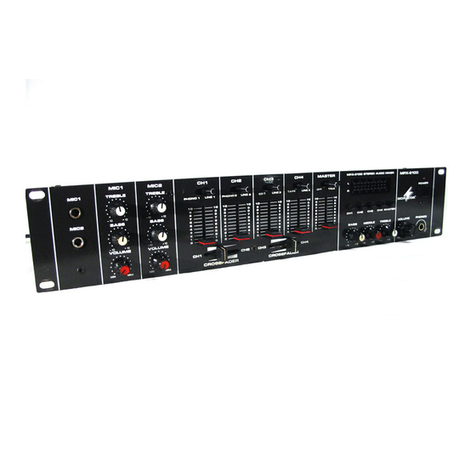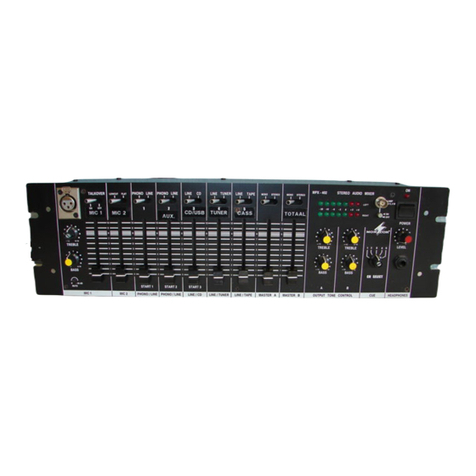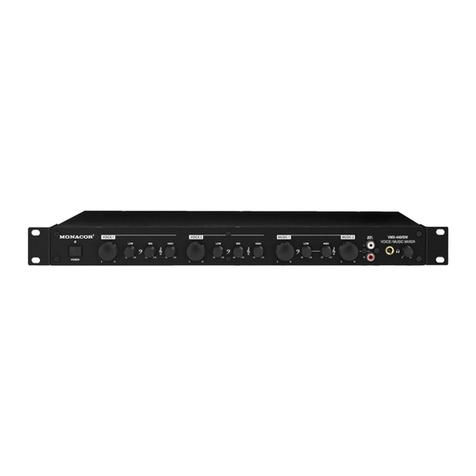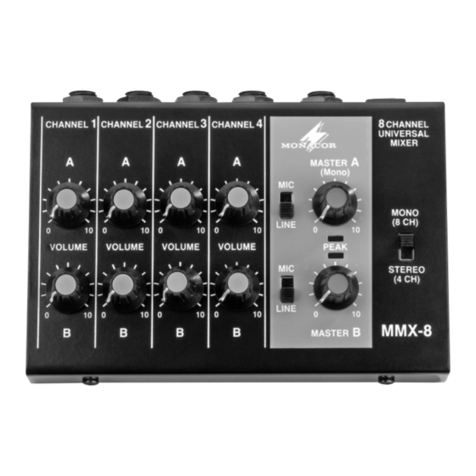●Nehmen Sie das Gerät nicht in Betrieb bzw. zie-
hen Sie sofort den Netzstecker aus der Steck-
dose, wenn:
1. sichtbare Schäden am Gerät oder an der Netz-
anschlußleitung vorhanden sind,
2. nach einem Sturz oder ähnlichem der Verdacht
auf einen Defekt besteht,
3. Funktionsstörungen auftreten.
Lassen Sie das Gerät in jedem Fall in einer Fach-
werkstatt reparieren.
●Eine beschädigte Netzanschlußleitung darf nur
durch den Hersteller oder eine autorisierte Fach-
werkstatt ersetzt werden.
●Ziehen Sie den Netzstecker nie an der Zuleitung
aus der Steckdose.
●Verwenden Sie für die Reinigung nur ein trocke-
nes, weiches Tuch, auf keinen Fall Chemikalien
oder Wasser.
●Wird das Gerät zweckentfremdet, falsch bedient
oder nicht fachgerecht repariert, kann für eventu-
elle Schäden keine Haftung übernommen werden.
●Soll das Gerät endgültig aus dem Betrieb genom-
men werden, übergeben Sie es zur Entsorgung
einem örtlichen Recyclingbetrieb.
3 Einsatz- und Aufstellmöglichkeiten
Mit diesem 6-Kanal-Mischpult lassen sich Geräte
mit Line-Ausgang (z.B. CD-Spieler, Tape-Deck,
Tuner) und Mikrofone (auch phantomgespeiste) auf
einen Stereo- oder Mono-Ausgangskanal mischen.
Der MMX-60 eignet sich dadurch z.B. als Vormi-
scher für eine Mikrofongruppe (Chor, Schlagzeug
usw.) oder als Mischpult in Beschallungsanlagen.
Das Gerät ist für die Montage in ein Rack
(482mm/19") vorgesehen, kann aber auch als frei-
stehendes Tischgerät verwendet werden. Für den
Einbau in ein Rack wird 1HE (Höheneinheit) =
44,45mm benötigt.
Hinweis: Werden phantomgespeiste Mikrofone
angeschlossen, muß vor dem Einbau in ein Rack
die Phantomspeisung dazugeschaltet werden
(siehe Kapitel 4.1).
4 Gerät anschließen
Vor dem Anschluß bzw. vor dem Verändern vonAn-
schlüssen das Mischpult und die anzuschließenden
Geräte ausschalten.
Soll die Talkover-Funktion (siehe Kapitel 5.3) ge-
nutzt werden, bei der Belegung der Kanäle beach-
ten, daß ein Signal auf Kanal CH1 oder CH2 die
Lautstärke der Kanäle CH2–CH6 bzw. CH3–CH6
verringern kann. Beispiel: Kanäle CH1 und CH2 für
die Mikrofone der Sprecher oder Akteure, die übri-
gen Kanäle für das Begleitprogramm oder die
Hintergrundmusik.
1) Geräte mit Line-Pegel (z.B. CD-Spieler, Tape-
Deck, Tuner usw.) an die sechs Cinch-Buchsen-
paare LINE (22) anschließen:
weiße Buchse L = linker Kanal
rote Buchse R = rechter Kanal
2) Mikrofone (symmetrisch oder asymmetrisch) an
die sechs XLR-Buchsen (23) anschließen. Für
phantomgespeiste Mikrofone die Phantomspei-
sung dazuschalten – siehe Kapitel 4.1.
Soll ein Mikrofonstecker wieder aus dem Misch-
pult herausgezogen werden, zur Entriegelung die
Taste PUSH der XLR-Buchse drücken.
3) Den Endverstärker für die Lautsprecher oder
ein nachfolgendes Gerät mit Line-Eingang
(Hauptmischpult, Effektgerät etc.) an die passen-
den Ausgangsbuchsen anschließen:
ein Gerät mit XLR-Eingang an die XLR-Buchsen
LEFT/A und RIGHT/B (19) und/oder
ein Gerät mit Cinch-Eingang an die Cinch-Buch-
sen LEFT/A und RIGHT/B (20)
4) Ein Aufnahmegerät für Tonaufnahmen kann an
die Cinch-Buchsen REC (21) angeschlossen wer-
den. Die Aufnahmelautstärke ist unabhängig von
der Einstellung der Ausgangspegelregler (14).
Die Aufzeichnung erfolgt unabhängig von der
Stellung des Schalters STEREO/MONO (13),
d.h. immer stereophon.
5) Über einen Kopfhörer läßt sich das Ausgangssi-
gnal des Mischpultes abhören. Dazu einen Kopf-
hörer (Impedanz minimal 2 x 8Ω) an die 6,3-mm-
Klinkenbuchse PHONES (16) anschließen.
6) Zuletzt den Netzstecker des Anschlußkabels (18)
in eine Steckdose (230V~/50Hz) stecken.
4.1 Mikrofon-Phantomspeisung dazuschalten
Um auch phantomgespeiste Mikrofone betreiben zu
können, läßt sich für jeden Mikrofoneingang
getrennt eine 12-V-Phantomspeisung dazuschalten.
1) Den Netzstecker aus der Steckdose ziehen.
2) Den Gehäusedeckel abschrauben.
3) Für die gewünschten Mikrofoneingänge die ent-
sprechenden Steckbrücken JP101 (für Kanal
CH1) bis JP601 (für Kanal CH6) von Aus nach
Ein, wie in Abb. 3 dargestellt, umstecken.
4) Den Gehäusedeckel wieder festschrauben.
5 Bedienung
1) Vor dem Einschalten sollten die Ausgangspegel-
regler (14) auf Null gestellt werden, um eventu-
elle Einschaltgeräusche zu vermeiden.
2) Das Gerät mit dem Ein-/Ausschalter POWER (17)
einschalten. Die rote Betriebsanzeige (5) leuchtet.
3) Die angeschlossenen Geräte einschalten, zuletzt
immer den Endverstärker für die Lautsprecher.
4) Beim Ausschalten der Anlage immer zuerst den
Endverstärker abschalten.
Achtung! Zum Zuschalten der Phantomspeisung
muß das Mischpult geöffnet werden.
Darum darf dies nur durch eine qualifi-
zierte Fachkraft erfolgen.
Vorsicht! Ist die Phantomspeisung dazuge-
schaltet, dürfen keine asymmetri-
schen Mikrofone an den entspre-
chenden Kanälen angeschlossen
werden. Anderenfalls können diese
Mikrofone beschädigt werden.
In any case the unit must be repaired by skilled
personnel.
●A damaged mains cable must be replaced by the
manufacturer or by skilled personnel only.
●Never pull the mains cable to disconnect the
mains plug from the socket.
●For cleaning only use a dry, soft cloth, by no
means chemicals or water.
●If the unit is used for other purposes than originally
intended, if it is not correctly operated or not re-
paired by skilled personnel, no liability for any
damage will be accepted.
●If the unit is to be put out of operation definitively,
take it to a local recycling plant for disposal.
●Important for U.K. Customers!
The wires in this mains lead are coloured in ac-
cordance with the following code:
blue = neutral
brown = live
As the colours of the wires in the mains lead of this
appliance may not correspond with the coloured
markings identifying the terminals in your plug,
proceed as follows:
1. The wire which is coloured blue must be con-
nected to the terminal in the plug which is
marked with the letter Nor coloured black.
2. The wire which is coloured brown must be con-
nected to the terminal which is marked with the
letter Lor coloured red.
3 Applications and Setting-up
With this 6-channel mixer it is possible to mix units
with line output (e.g. CD player, tape deck, tuner)
and microphones (also phantom-powered) to a
stereo or mono output channel. Thus, the MMX-60
is suitable e.g. as pre-mixer for a microphone group
(chorus, drums, etc.) or as mixer in PA systems.
The unit is provided for mounting into a rack
(482mm/19"), but it can also be used as a table top
unit. For the installation into a rack 1 rack space =
44.45mm is required.
Note: if phantom-powered microphones are con-
nected, the phantom power must be switched on
prior to the rack installation (see chapter 4.1).
4 Connection of the Unit
Prior to the connection or changing of connections,
switch off the mixer and the units to be connected.
For using the talkover function (see chapter 5.3),
when connecting the channels observe that a signal
on channel CH1 or CH2 can change the volume of
channels CH2 to CH6 or CH3 to CH6. Example:
CH1 and CH2 for the microphones of speaking or
acting persons, the remaining channels for the
accompanying programme or the background
music.
1) Connect units with line level (e.g. CD player,
tape deck, tuner, etc.) to the six pairs of phono
jacks LINE (22):
white jack L = left channel
red jack R = right channel
2) Connect microphones (balanced or unbalanced)
to the six XLR jacks (23). For phantom-powered
microphones switch on the phantom power – see
chapter 4.1.
For disconnecting a microphone plug from the
mixer, press the button PUSH of the XLR jack for
unlocking.
3) Connect the power amplifier for the speakers or
a subsequent unit with line input (main mixer,
effect unit, etc.) to the matching output jacks:
a unit with XLR input to the XLR jacks LEFT/A
and RIGHT/B (19) and/or
a unit with phono input to the phono jacks
LEFT/A and RIGHT/B (20)
4) A recording unit for audio recordings can be
connected to the phono jacks REC (21). The re-
cording volume is independent of the adjustment
of the output level controls (14). The recording is
made independent of the position of switch
STEREO/MONO (13), i.e. it is always stereo-
phonic.
5) Via headphones it is possible to monitor the out-
put signal of the mixer. For this purpose connect
headphones (minimum impedance 2 x 8Ω) to the
6.3 mm jack PHONES (16).
6) Finally connect the mains plug of the cable (18)
to a mains socket (230V~/50Hz).
4.1 Switching on the microphone phantom
power
To be able to operate phantom-powered microphones
as well, it is possible to switch on a 12V phantom
power separately for each microphone input.
1) Disconnect the mains plug from the mains
socket.
2) Screw off the housing cover.
3) For the desired microphone inputs rearrange the
corresponding jumpers JP101 (for channel CH1)
to JP601 (for channel CH6) from Off to On, as
shown in fig. 3.
4) Tightly screw on the housing cover again.
5 Operation
1) Prior to switching on, the output level controls
(14) should be set to zero to avoid a possible
switching-on noise.
2) Switch on the unit with the POWER switch (17).
The red power indication (5) lights up.
3) Switch on the connected units, always switch on
the power amplifier for the speakers last of all.
Attention! To switch on the phantom power, the
mixer must be opened. For this reason
this must only be done by qualified per-
sonnel.
Caution! If the phantom power is switched on,
no unbalanced microphones must
be connected to the corresponding
channels. Otherwise these micro-
phones may be damaged.
5
GB
D
A
CH

